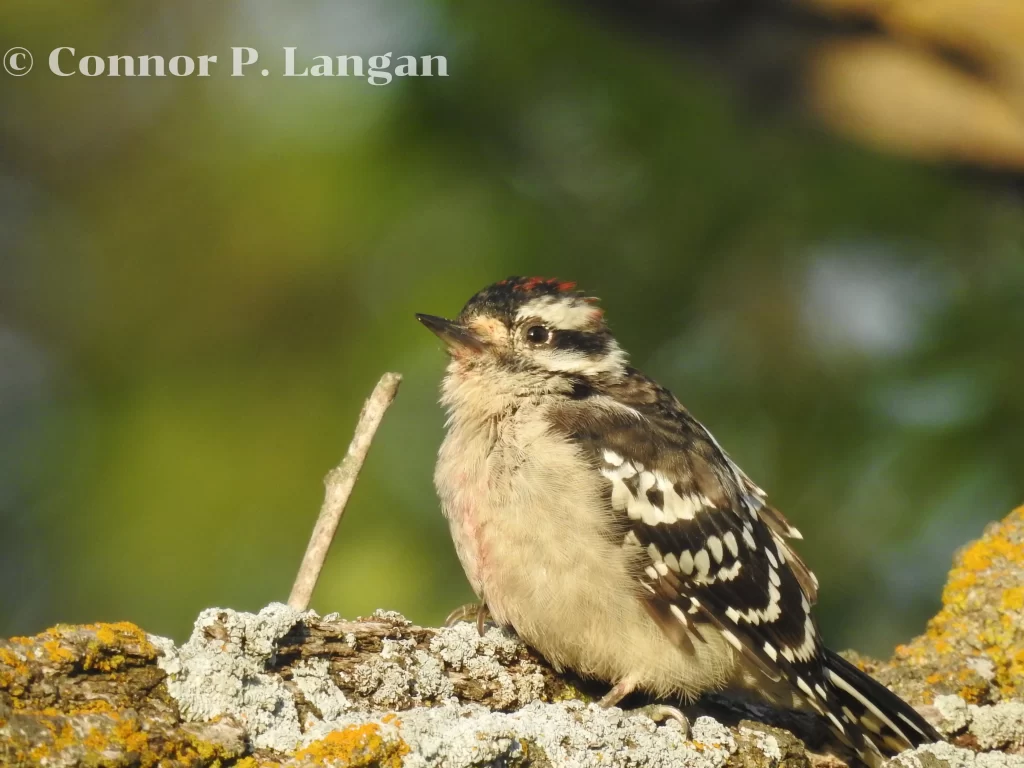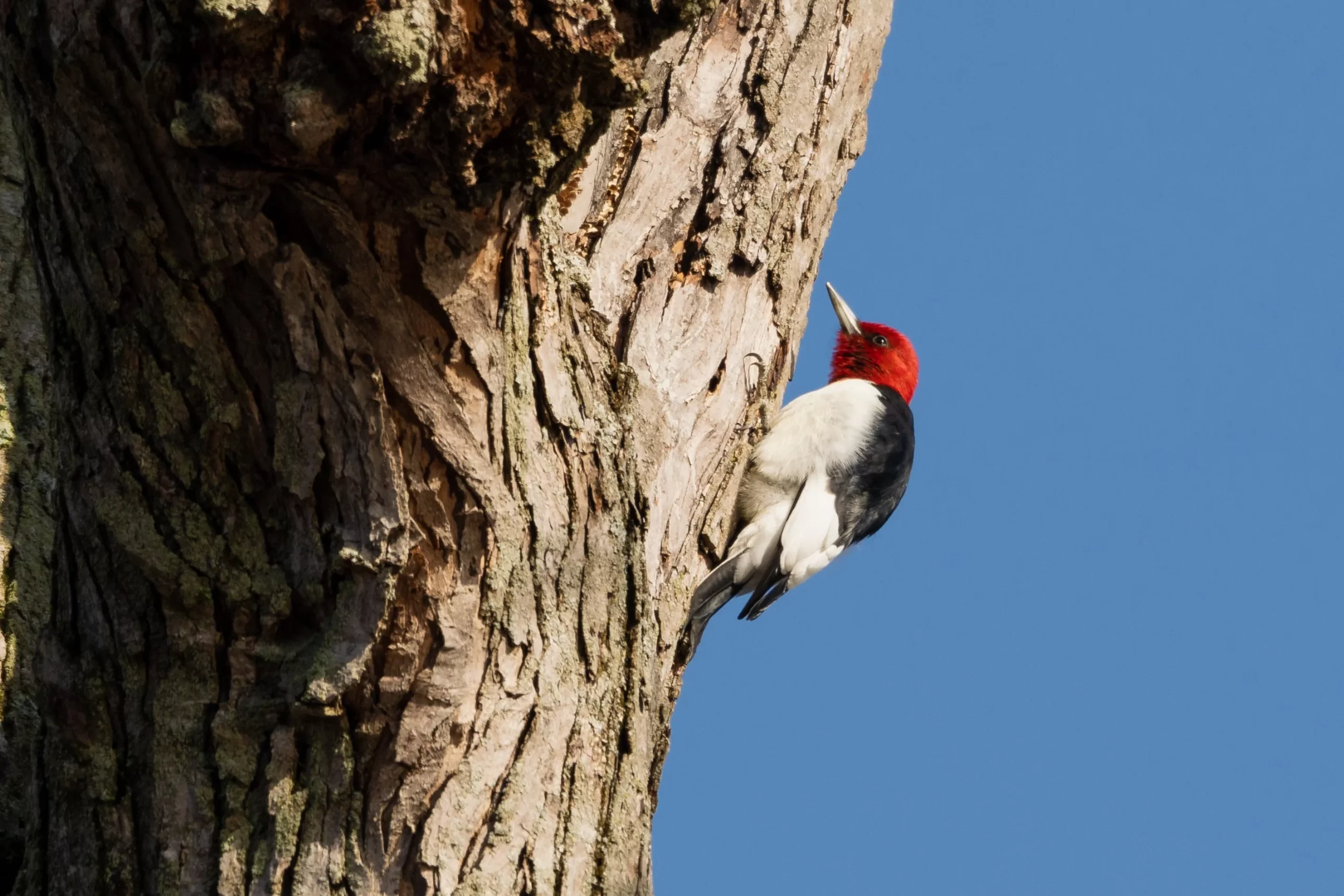Those who have taken a walk through a forested area in Indiana were likely met with the sounds of pecking on trees. Some may assume that woodpeckers are responsible for those sounds, but are there woodpeckers in Indiana?
Yes, there are seven common types of woodpeckers in Indiana! However, these creatures can be rather elusive as they navigate their forested homes. This can make it difficult for Hoosiers to get to know the woodpeckers in their home state. Not to worry – this photo guide to Indiana woodpeckers will undoubtedly help you learn the state’s woodpeckers.
There are seven Indiana woodpecker types, with some being migratory and other year-round residents. In addition to learning how to identify these birds, I will discuss where you can find woodpeckers of Indiana and how their populations are faring in the state. Let’s discuss facts about the woodpeckers in Indiana!
Table of Contents
7 Types of Woodpeckers In Indiana
Downy Woodpecker

Identification
Downy Woodpeckers are the smallest types of woodpeckers in Indiana. They have plain white undersides and checkered black and white backs. Moreover, a sizable white, unmarked patch is visible on their backs. Males can be distinguished from females by a small red patch on the back of their heads. Both sexes have white supercilia and a black mask that goes through their eyes. Note the stubby bills of Downies.
Habitat and Range
Downy Woodpeckers thrive in deciduous forests, making Indiana an optimal location for these birds. They are especially numerous within wooded areas that border waterways.
Downy Woodpeckers are naturally very adaptable, and–thanks to their small size–they can flourish in smaller wooded areas than Indiana’s other woodpeckers. Therefore, this woodpecker in Indiana may be found in parks, farmsteads, and woodlots with what seems to be a minimal amount of trees.
Downies may be found throughout the entire state of Indiana. They are less numerous in agricultural areas and big cities, but they can still be found in such habitats provided that some trees are present.
Status
The title of Indiana’s most numerous woodpecker goes to the Downy Woodpecker. They have been observed more than 300,000 times in the state according to eBird data, being common woodpeckers in Northern Indiana and other parts of the state.
Hairy Woodpecker

Identification
Hairy Woodpeckers look like larger versions of Downy Woodpeckers, as they have the same plumage patterns and colors. Although it can be difficult for beginning birders to separate a Hairy from a Downy, one can use the larger size and proportionately longer bills to confirm identification of these Indiana woodpeckers.
Habitat and Range
Hairy Woodpeckers thrive in sizable tracts of trees where they do equally well in deciduous or coniferous habitats. However, since most forests in Indiana are deciduous in their composition, conifers are not much of a consideration. Mature forests are the ideal habitat for Hairy Woodpeckers, as they do not do as well in young stands of trees.
Look for these woodpeckers of Indiana in parks, woodlots, and other small collections of trees, but they are not common in these areas, lacking the adaptability that Downy Woodpeckers enjoy.
Status
Hairy Woodpeckers are the fifth most abundant Indiana woodpecker, with Pileated Woodpeckers–surprisingly–having more observations as per eBird. However, Hairy Woodpeckers are surely more numerous compared to Pileated Woodpeckers in reality. Just shy of 100,000 observations have been submitted for Hairy Woodpeckers in Indiana.
Northern Flicker

Identification
Northern Flickers have the most diverse patterns and color schemes of any Indiana woodpecker. Their faces are brownish, while their crowns and napes are gray. Both sexes have a red patch on the backs of their heads, but only males have black submoustachial stripes.
Northern Flickers have a dark necklace that spans across their breasts, while their undersides are beige with black spots. Meanwhile, their backs are dark brown with black chevrons. Northern Flickers have white undertail coverts and yellow tail feathers. They are the second largest Indiana woodpecker.
Habitat and Range
Northern Flickers make a strong case for Indiana’s most versatile woodpeckers. They can be found in forests, parks, farmsteads, windbreaks, cemeteries, and many more habitats. So long as a habitat has dead trees and adjacent open ground, Northern Flickers can thrive.
Dead trees are required by this species as locations in which they can excavate a nest. Likewise, those who have observed Northern Flickers know that they have a peculiar habitat of foraging on the ground. They do this to access terrestrial insects like ants and termites, so they need relatively open habitats.
Status
Northern Flickers are common in Indiana, being observed regularly Although some of these woodpeckers migrate south in winter, many remain in Indiana.
Pileated Woodpecker

Identification
Pileated Woodpeckers are the largest woodpecker in Indiana by a substantial margin, so there will be no mistaking these birds for any other woodpeckers. They have large, chisel-like bills and red crests.
Additionally, their bodies are primarily black, but white wing patches flash in flight.
Males and females are identical in their appearance except for one feature – a red submoustachial stripe in males that is black in females.
Habitat and Range
Considering their large size, it should come as no surprise that Pileated Woodpeckers require sizable tracts of mature woodlands. Therefore, checking one of Indiana’s state forests or Hoosier National Forest is likely to reward a birder with an observation of a Pileated Woodpecker.
However, Pileated Woodpeckers are not limited to massive swaths of forest. Indeed, some birds can be found in parks with modest stands of timber.
Status
Pileated Woodpeckers are fairly common in Indiana, although their numbers are never as dense as those of other Indiana woodpeckers because they have much larger territories. Nevertheless, Pileated Woodpeckers have been observed more than 100,000 times in Indiana as per eBird data. Therefore, if you want to see a Pileated Woodpecker, Indiana may be a great place to check.
Red-bellied Woodpecker

Identification
Red-bellied Woodpeckers are medium-sized woodpeckers with black and white zebra patterning on their backs. Although differences between males and females are subtle in some of the other woodpeckers in Indiana, it is rather easy to discern between the sexes in this species. Look for a full red hood in males and a partial red hood in females.
Red-bellied Woodpeckers have unmarked, beige undersides. Immature birds look like adults without red coloration.
Habitat and Range
Red-bellied Woodpeckers are habitat generalists much like Northern Flickers. These Indiana woodpeckers can be found in a wide array of forested areas, and they can make do with nominal amounts of trees present on a landscape.
Therefore, they are among the most common woodpeckers in agricultural settings and other open landscapes where many other woodpeckers fail. Moreover, they are year-round residents who commonly visit bird feeders, and they are abundant Northern Indiana woodpeckers.
Status
Red-bellied Woodpeckers are second to only Downy Woodpeckers in terms of the most common Indiana woodpecker types. Downy Woodpeckers currently hold a narrow lead over Red-bellied Woodpeckers in terms of their eBird observations, with just shy of 300,000 Red-bellied Woodpeckers observed.
Red-headed Woodpecker

Identification
Red-headed Woodpeckers are the only Indiana woodpecker that features sexual monomorphism. In other words, it is impossible to tell a mated pair of male and female Red-headed Woodpeckers apart.
Red-headed Woodpeckers are stunning with their entirely red heads and black and white checkerboard wings. Their undersides are a clean white color. Immatures have gray heads instead of red.
Habitat and Range
Red-headed Woodpeckers may inhabit dense forests during the nonbreeding season, but come spring, they establish territories in collections of trees that feature open areas within them. Therefore, areas disturbed by human activities or fire may be beneficial to this woodpecker in Indiana.
Oak savannas, parks, and acreages are often suitable breeding habitats for Red-headed Woodpeckers. Some birds may migrate south in winter, but of these woodpeckers of Indiana remain throughout the year.
Status
Red-headed Woodpeckers are not as common as they once were, however, they can still be readily observed throughout Indiana. More than 62,000 observations have been submitted to eBird.
Yellow-bellied Sapsucker

Identification
Yellow-bellied Sapsuckers have red foreheads, black chests, and yellow collars. Although one would expect them to have yellow bellies, in reality, their stomachs are grayish with a slight yellow wash.
Yellow-bellied Sapsuckers have black backs with white patches. Meanwhile, their undersides are pale with black chevrons.
Immature birds look like very drab versions of the adults, as they lack any red or yellow. Males can be separated from females by their red throats.
Habitat and Range
Yellow-bellied Sapsuckers are the only one of the seven types of woodpeckers in Indiana that do not breed in the state. Therefore, birders will have to learn about habitats favored during migration rather than the breeding season.
Look for Yellow-bellied Sapsuckers along woodland edges, open woodlands, cemeteries, parks, and windbreaks.
Status
Yellow-bellied Sapsuckers are the least numerous Indiana woodpeckers by number, as about 15,000 have been observed. They regularly winter in the southern half of Indiana.

